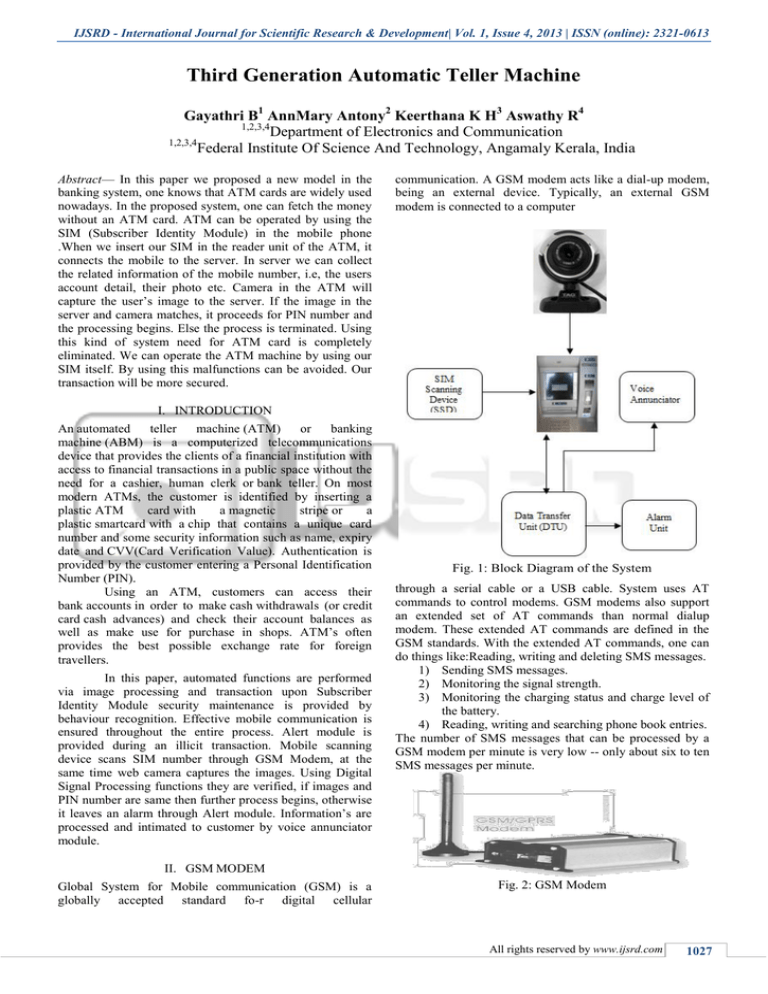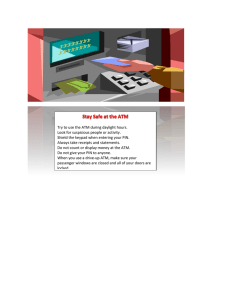
IJSRD - International Journal for Scientific Research & Development| Vol. 1, Issue 4, 2013 | ISSN (online): 2321-0613
Third Generation Automatic Teller Machine
Gayathri B1 AnnMary Antony2 Keerthana K H3 Aswathy R4
1,2,3,4
Department of Electronics and Communication
1,2,3,4
Federal Institute Of Science And Technology, Angamaly Kerala, India
Abstract— In this paper we proposed a new model in the
banking system, one knows that ATM cards are widely used
nowadays. In the proposed system, one can fetch the money
without an ATM card. ATM can be operated by using the
SIM (Subscriber Identity Module) in the mobile phone
.When we insert our SIM in the reader unit of the ATM, it
connects the mobile to the server. In server we can collect
the related information of the mobile number, i.e, the users
account detail, their photo etc. Camera in the ATM will
capture the user’s image to the server. If the image in the
server and camera matches, it proceeds for PIN number and
the processing begins. Else the process is terminated. Using
this kind of system need for ATM card is completely
eliminated. We can operate the ATM machine by using our
SIM itself. By using this malfunctions can be avoided. Our
transaction will be more secured.
communication. A GSM modem acts like a dial-up modem,
being an external device. Typically, an external GSM
modem is connected to a computer
I. INTRODUCTION
An automated
teller
machine (ATM)
or
banking
machine (ABM) is a computerized telecommunications
device that provides the clients of a financial institution with
access to financial transactions in a public space without the
need for a cashier, human clerk or bank teller. On most
modern ATMs, the customer is identified by inserting a
plastic ATM
card with
a magnetic
stripe or
a
plastic smartcard with a chip that contains a unique card
number and some security information such as name, expiry
date and CVV(Card Verification Value). Authentication is
provided by the customer entering a Personal Identification
Number (PIN).
Using an ATM, customers can access their
bank accounts in order to make cash withdrawals (or credit
card cash advances) and check their account balances as
well as make use for purchase in shops. ATM’s often
provides the best possible exchange rate for foreign
travellers.
In this paper, automated functions are performed
via image processing and transaction upon Subscriber
Identity Module security maintenance is provided by
behaviour recognition. Effective mobile communication is
ensured throughout the entire process. Alert module is
provided during an illicit transaction. Mobile scanning
device scans SIM number through GSM Modem, at the
same time web camera captures the images. Using Digital
Signal Processing functions they are verified, if images and
PIN number are same then further process begins, otherwise
it leaves an alarm through Alert module. Information’s are
processed and intimated to customer by voice annunciator
module.
Fig. 1: Block Diagram of the System
through a serial cable or a USB cable. System uses AT
commands to control modems. GSM modems also support
an extended set of AT commands than normal dialup
modem. These extended AT commands are defined in the
GSM standards. With the extended AT commands, one can
do things like:Reading, writing and deleting SMS messages.
1) Sending SMS messages.
2) Monitoring the signal strength.
3) Monitoring the charging status and charge level of
the battery.
4) Reading, writing and searching phone book entries.
The number of SMS messages that can be processed by a
GSM modem per minute is very low -- only about six to ten
SMS messages per minute.
II. GSM MODEM
Global System for Mobile communication (GSM) is a
globally accepted standard fo-r digital cellular
Fig. 2: GSM Modem
All rights reserved by www.ijsrd.com
1027
Third Generation Automatic Teller Machine
(IJSRD/Vol. 1/Issue 4/2013/0051)
III. FACE RECOGNITION
Principal component analysis (PCA) involves a
mathematical procedure which extracts facial features for
recognition, this approach transforms face images into a
smallest of characteristic feature images called Eigen faces.
The first principal component accounts for as much of the
variability in the data as possible, and each succeeding
component accounts for as much of the remaining
variability as possible. These methods capture the local
facial features and their geometric relationships. They often
locate anchor points at key facial features (eyes, nose,
mouth, etc.), connect these points to form a net and then
measure the distances and angles of the net to create a
unique face ‘print’.
the LUTs of the FPGA. The gate groupings are sent to the
place & route tool that assigns them to LUTs at various
locations in the FPGA and then determines how to connect
them together using the routing resources (wires) in the
switching matrix. This part takes the most time as finding a
placement that can be routed efficiently requires a lot of
computation bit stream generator it takes the output of the
implementation phase, combines it with a few other
configuration settings, and outputs a binary bit stream. This
bit stream (which, depending upon the size of the FPGA can be
many megabits in length) contains the truth-tables that will be
loaded into the RAM of every LUT and the connection
settings for the wiring matrix that will connect them. At this
point, a bit stream is just a bunch of 1s and 0s in a file on
the computer. The downloader will transfer this file into a
physical FPGA chip. In most cases, this chip is already
mounted on a circuit board where it waits for the bit stream
that will make it perform its intended function.
ATM status report block
It send status of different ATM, whether working
or not .to particular customer mobile via Spartan 3a
hardware and UART.
V. CONCLUSION
Fig. 3: PCA: Principal Component Analysis
It converts the input and database face images to
corresponding Eigen values. Eigen value corresponds to the
energy of the face images. These Eigen values are
compared. Here is how Eigen value is calculated?
1) Read image.
2) Find its mean value = average of the colour
3) Find difference image = input image-mean
4) Co-variance matrix = gives effective colour
5) 5. Eigen value = gives energy of image
IV. SOFTWARE SIMULATION
From this we implement image-recognition techniques that
can provide the important functions required by advanced
intelligent ATM Security, to avoid theft and protect the
usage of unauthenticated users. Secured and safety
environment system for automobile users will be provided
by implementing this project. We can predict the theft by
using this system in our day to day life. We Predict and
indent system for the society.
REFERENCES
[1] Faune Hughes, Daniel Lichter, Richard Oswald, and
Michael Whitfield ,Face Biometrics: A Longitudinal
Study, Seidenberg School of CSIS, Pace University,
White Plains, NY 10606,USA.
[2] Gary G.Yen, Nethrie Nithianandan, Facial Feature
Extraction Using Genetic Algorithm, Intelligent
Systems and Control Laboratory School of Electrical
and Computer Engineering. Oklahoma State
University, Stillwater, OK 74074-5032, USA
[3] D.L. Jiang, Y.X. Hu, S.C. Yan, H.J. Zhang, "Efficient
3D
Reconstruction
for
Face
Recognition",
0031_3203/2004
Pattern
recognitionsociety:doi:10.1016/j.patcog.2004.11.004
[4] Animetrics offers FaceR™ CredentialME service on
Sprint 3G and 4G networks August 12th, 2010.
Fig. 4: Software Simulation Block Diagram
Logic synthesizer, Synthesizer transforms the VHDL into
a net list. The net list is just a description of the various
logic gates in our design and how they are interconnected
Implementation phase. It employs three different tools. A
translator merges together one or more net lists along with
any design constraints. This is fed to a mapper that combines
gates in the net list into groups that will fit efficiently into
All rights reserved by www.ijsrd.com
1028






